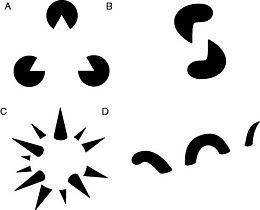Kanizsa triangle
The Kanizsa triangle is an optical illusion first described by the Italian psychologist Gaetano Kanizsa in 1955. The Kanizsa triangle is known as a subjective or illusory contour illusion. The Kanizsa triangle is similar to other contour illusions like the Ehrenstein illusion. Like many other visual and perceptual illusions, study of the Kanizsa triangle has led to greater understanding of how the brain and eyes perceive visual information. Such figures are also used to great effect by artists, reflecting the endless creativity of human nature and the equally endless ability we have to appreciate creative and novel phenomena.
Discovery
The Kanizsa triangle is named for the Italian psychologist Gaetano Kanizsa, who published his findings of the optical illusion in a 1955 edition of the Italian journal Rivista di Psicologia. He noticed that we see a white triangle, on top of and partly occluding disks and another triangle. The triangle, however, has no physically measurable existence although they appear to observers as significantly brighter than the background.
Description
When looking at the Kanizsa triangle, one sees the shape of a white, equilateral triangle in the center that appears to occlude the shapes around it. The nonexistent white triangle also appears to be brighter than the surrounding area, but in fact it has the same brightness as the background.
Explanation
The "phantom edge phenomena" (seeing an outline that is not actually there) is due to what neuropsychologists call the "T-effect." Groups of neural cells see breaks in lines or shapes, and if given no further input, will assume that there is a figure in front of the lines. Scientists believe that this happens because the brain has been trained to view the break in lines as an object that could pose a potential threat. With lack of additional information, the brain errs on the side of safety and perceives the space as an object. The circle is the most simple and symmetrical object, so the mind usually sees a circle unless active effort is made to see an alternate shape.[1]
This illusion is an example of reification or the constructive or generative aspect of perception, by which the experienced percept contains more explicit spatial information than the sensory stimulus on which it is based.
For instance, picture A shows the typical Kanizsa triangle. In pictures B and D the eye will recognize disparate shapes as "belonging" to a single shape, in C a complete three-dimensional shape is seen, where in actuality no such thing is drawn. Reification can be explained by progress in the study of illusory contours, which are treated by the visual system as "real" contours.
Applications
Like many other visual and perceptual illusions, the Kanizsa triangle helps neuropsychologists study the various ways the brain and eyes perceive visual information. They are also used to great advantage by artists, who incorporate subjective contours and apparent brightening of figures to great effect in their works.
Notes
- â "The Grid illusion of Spot 06" The Visual Perception Lab. Retrieved December 4, 2007.
ReferencesISBN links support NWE through referral fees
- Gregory, Richard L. 1997. Eye and Brain. Princeton University Press. ISBN 0691048371
- Hoffman, Donald D. 2000. Visual Intelligence: How We Create What We See. W. W. Norton & Company. ISBN 0393319679
- Koch, Christof. 2004. The Quest for Consciousness: A Neurobiological Approach. Roberts & Company Publishers. ISBN 0974707708
- Norretranders, Tor. 1999. The User Illusion: Cutting Consciousness Down to Size. Penguin. ISBN 0140230122
Credits
New World Encyclopedia writers and editors rewrote and completed the Wikipedia article in accordance with New World Encyclopedia standards. This article abides by terms of the Creative Commons CC-by-sa 3.0 License (CC-by-sa), which may be used and disseminated with proper attribution. Credit is due under the terms of this license that can reference both the New World Encyclopedia contributors and the selfless volunteer contributors of the Wikimedia Foundation. To cite this article click here for a list of acceptable citing formats.The history of earlier contributions by wikipedians is accessible to researchers here:
The history of this article since it was imported to New World Encyclopedia:
Note: Some restrictions may apply to use of individual images which are separately licensed.

